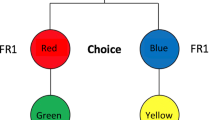Abstract
Two pigeons were employed in an experiment in which pecking at one key on a fixed-ratio schedule (Fr 30) earned food reinforcement followed by a timeout. Pecking at another key changed the color of the first key and provided more reinforcers on Fr 30 before the timeout. Pecking the second key was maintained when more reinforcers were available before the timeout but not when only one was given. Pecking the second key was also maintained better when the timeout was 1 min than when it was 3 s. Finally pecking the second key was maintained better when the first key changed color to signal the additional reinforcers than when it remained the same color with the additional reinforcers. It was concluded that the color change acted as a conditioned reinforcer which was based on a relationship between the key color and the number of reinforcers provided.
Similar content being viewed by others
References
FERSTER, C. B. (1958). Control of behavior in chimpanzees and pigeons by time-out from positive reinforcement. Psycholgoical Monographs, 72 (8, Whole No. 461).
FINDLEY, J. D. (1962). An experimental outline for building and exploring multi-operant behavior repertoires. Journal of the Experimental Analysis of Behavior, 5, 113–166.
KELLEHER, R. T., & GOLLUB, L. R. (1962). A review of positive conditioned reinforcement. Journal of the Experimental Analysis of Behavior, 5, 543–597.
KENDALL, S. B. (1967). Some effects of fixed-interval duration on response rate in a two-component chain schedule. Journal of the Experimental Analysis of Behavior, 10, 341–347.
KIMBLE, G. (1961). Hilgard and Marquis’ conditioning and learning. Englewood Cliffs, NJ: Prentice-Hall.
MACKINTOSH, N. J. (1974). The psychology of animal learning. London: Academic Press.
MCDIARMID, C. G., & RILLING, M. (1965). Reinforcement delay and reinforcement rate as determinants of schedule preference. Psychonomic Science, 2, 195–196.
MOORE, J. (1979). Choice and number of reinforcers. Journal of the Experimental Analysis of Behavior, 32, 51–63.
MORSE, W. H., & HERRNSTEIN, R. J. (1956). The maintenance of avoidance behavior using the removal of a conditioned reinforcer as the aversive stimulus. American Psychologist, 11, 430, (abstract).
PONIEWAZ, W. R. (1984). Effects of preference of reinforcement delay, number of reinforcers, and terminal-link duration. Journal of the Experimental Analysis of Behavior, 42, 255–266.
SHULL, R. L., SPEAR, D. J., & BRYSON, A. E. (1981). Delay or rate of food delivery as a determiner of response rate. Journal of the Experimental Analysis of Behavior, 35, 119–143.
THOMAS, J. R. (1965). Discriminated time-out avoidance in pigeons. Journal of the Experimental Analysis of Behavior, 8, 329–338.
WIKE, E. L. (1966). Secondary reinforcement. New York: Harper and Row.
Author information
Authors and Affiliations
Additional information
This research was supported by Grant A0258 from Natural Sciences and Engineering Research Council.
Rights and permissions
About this article
Cite this article
Kendall, S.B. Conditioned Reinforcement Based On Multiple Primary Reinforcers. Psychol Rec 36, 215–223 (1986). https://doi.org/10.1007/BF03394942
Published:
Issue Date:
DOI: https://doi.org/10.1007/BF03394942




